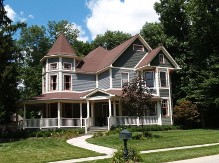What’s Ahead For Mortgage Rates This Week – June 30, 2014
 Last week brought several economic and housing sector reports including Existing Home Sales, Case-Shiller and FHFA home prices for April, as well as New Home Sales. Freddie Mac’s weekly mortgage rates survey and the weekly report on new jobless claims were released on Thursday, and Consumer Sentiment for June rounded out the week on Friday.
Last week brought several economic and housing sector reports including Existing Home Sales, Case-Shiller and FHFA home prices for April, as well as New Home Sales. Freddie Mac’s weekly mortgage rates survey and the weekly report on new jobless claims were released on Thursday, and Consumer Sentiment for June rounded out the week on Friday.
Existing Home Sales Stronger than Expected!
Good news came from the National Association of REALTORS® Existing Home Sales report for May, which reported 4.89 million previously owned homes sold on a seasonally-adjusted annual basis. Analysts had projected a seasonally-adjusted annual figure of 4.75 million existing homes sold based on April’s reading of 4.65 million existing homes sold; April’s reading was later adjusted to 4.66 million. May’s reading represented a monthly increase of 4.90 percent over April’s reading and was the second consecutive monthly increase in previously owned home sales.
The median sales price for existing homes sold in May was $213,400, which represented a 5.10 percent increase year-over-year.
May’s reading for existing home sales was the highest in seven months, and mortgage rates trended down during May, but strict lending standards were cited as a significant obstacle to first-time homebuyers.
Federal Reserve Chair Janet Yellen recently said in a press conference that mortgage lenders “need more clarity” as to their potential liability for failed mortgages. Mortgage lenders and loan servicing companies can be required to repurchase defaulted loans or to reimburse Fannie Mae and Freddie Mac for losses associated with mortgage defaults and foreclosures.
Case-Shiller, FHFA Report Slower Pace for Home Price Growth
The S&P Case-Shiller Home Price Index and FHFA’s House Price Index for April documented slowing rates of home price growth. Case-Shiller reported a 10.80 percent year-over-year growth in home prices for April, and FHFA reported a year-over-year gain of 5.90 percent rate of appreciation for home sales associated with mortgages owned by Fannie Mae and Freddie Mac.
Analysts noted that home price growth is leveling out after last year’s steep appreciation in home prices. While homeowners may disagree, economists say that a slower rate of home price growth can actually bode well for housing markets. More buyers can afford a home, which adds stability to housing markets. First-time buyers provide a foundation for home sales; if they cannot buy homes, then homeowners can’t sell existing homes and buy new homes. A slower but consistent rate of home price growth allows homeowners to build home equity, but won’t likely lead to housing “bubble.”
New Home Sales Blast Past Expectations, Mortgage Rates Fall
The U.S. Department of Commerce reported that new home sales for May reached a six-year high with a reading of 504,000 new homes sold on an annual basis. April’s reading exceeded expectations of 440,000 new homes sold as well as April’s adjusted reading of 425,000 new homes sold. The month-to-month increase in new home sales from April to May was the largest monthly increase in home sales in 22 years.
Although analysts caution that month-to-month seasonally-adjusted sales reports are volatile, this uptick in new home sales may help bolster builder confidence in housing markets. May prices for new homes also rose with the median home price at $282,000. This reading represents a year-over-year increase of 6.0 percent for new home prices.
The Northeast led regional results for new home sales with its reading of 54.50 percent; The West reported an increase of 34.00 percent. New home prices in the Southeast rose at an annual rate of 14.20 percent, and the Midwest region reported a 1.40 percent increase in new home prices. While analysts characterized the Northeast region’s May reading as exaggerated, overall results for new home prices indicate a comeback for new home prices.
Freddie Mac put some icing on the good news cake with its weekly mortgage rates report. Average rates for a 30-year fixed rate mortgage dropped to 4.14 percent with discount points lowered to 0.50 percent. The average rate for a 15-year fixed rate mortgage fell by eight basis points to 3.22 percent with discount points unchanged at 0.50 percent. The average rate for a 5/1 adjustable rate mortgage fell by two basis points to 2.98 percent with discount points lower at 0.40 percent.
Thursday’s Weekly Jobless Claims Report reading fell by 2000 new claims to a seasonally adjusted reading of 312,000 new claims filed. Analysts had expected a reading of 310,000 new jobless claims. 214,000 per month have been added to the economy from January to May 2014.
Positive economic developments were not lost on consumers. The Consumer Sentiment Index for June posted a reading of 82.5 against an expected reading of 81.9 and May’s reading of 81.2.
This Week’s News
Scheduled economic news includes Pending Home Sales, Construction Spending, the ADP Employment report, and the Non-farm Payrolls Report. The National Unemployment Rate report along with Freddie Mac’s PMMS and Weekly Jobless Claims round out the week. No news is scheduled for Friday’s Independence Day holiday.
 Both seasoned homeowners and first-time buyers know making the decision to purchase a new home is not one that is taken lightly. There are so many things to consider, from choosing a home with growth potential to finding a community to support a family’s interests and lifestyle.
Both seasoned homeowners and first-time buyers know making the decision to purchase a new home is not one that is taken lightly. There are so many things to consider, from choosing a home with growth potential to finding a community to support a family’s interests and lifestyle. The S&P Case-Shiller Index for April shows that while home prices continue to grow, they are doing so at a slower pace as compared to April 2013. The Case-Shiller 20 city index reports that home prices expanded at a year-over-year annual rate of 10.80 percent as compared to 12.40 percent in April 2013.
The S&P Case-Shiller Index for April shows that while home prices continue to grow, they are doing so at a slower pace as compared to April 2013. The Case-Shiller 20 city index reports that home prices expanded at a year-over-year annual rate of 10.80 percent as compared to 12.40 percent in April 2013.